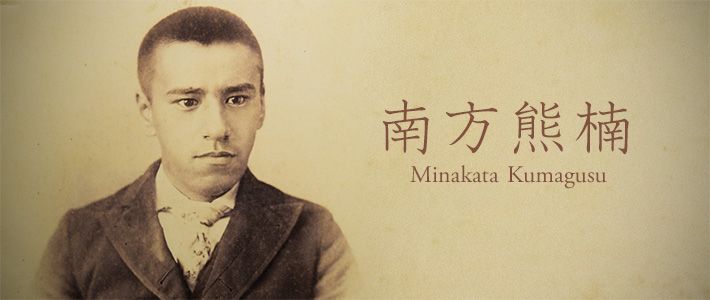
Minakata Kumagusu: The Meiji Polymath Who Broke the Mold
Culture- English
- 日本語
- 简体字
- 繁體字
- Français
- Español
- العربية
- Русский
Versatile, interdisciplinary geniuses have never been Japan’s strong suit. One factor is doubtless the nation’s linguistic isolation, which makes it particularly difficult for scholars to acquire proficiency in Indo-European languages. To achieve the wide-ranging erudition and sweeping insights of a Leibniz or Humboldt, one needs access to the languages of the ancient world as well as the major modern tongues, and the Japanese are at a disadvantage when it comes to this prerequisite.
Another reason is that the Meiji Restoration of 1868 interrupted the East Asian tradition of learning that had formed the foundation for scholarship in Japan up to that point. The overwhelming torrent of Western knowledge that came flooding in during the next few decades essentially destroyed the existing epistemological framework and left Japanese scholars with very little sense of a “big picture.”
It was a time of dizzying scientific progress, when the gap between the natural sciences and the humanities, with their focus on human values, seemed increasingly difficult to bridge. Attempting such a synthesis never even occurred to the elite scholars at Japan’s imperial universities as they struggled to bring the intellectual achievements of the West to their scientifically backward East Asian nation.
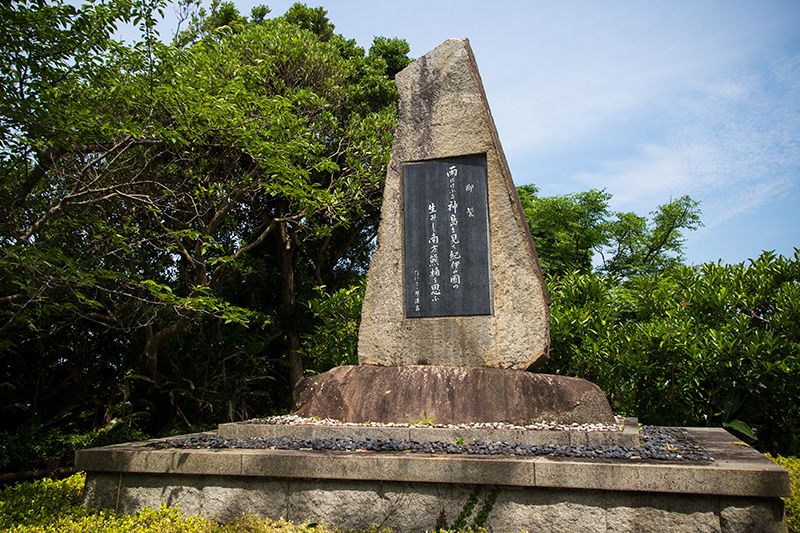 A memorial inscribed with a poem dedicated to Minakata Kumagusu by Emperor Shōwa stands outside the Minakata Kumagusu Museum in Shirahama, Wakayama Prefecture.
A memorial inscribed with a poem dedicated to Minakata Kumagusu by Emperor Shōwa stands outside the Minakata Kumagusu Museum in Shirahama, Wakayama Prefecture.
And yet this was the era that gave birth to Minakata Kumagusu (1867–1941), probably the most brilliant polymath Japan has ever produced. Blessed by nature with a prodigious memory and a keen intellect, he found the inner resources to develop his own potential to the full, rejecting the rigid constraints of academism and the unquestioning veneration of Western civilization that prevailed among Japanese scholars at the time. Venturing abroad to America and Europe, he debated issues with Western scholars on equal terms. He was proficient in English, French, Italian, German, Latin, and Spanish and had a working knowledge of ancient Greek, Sanskrit, and Hebrew, to say nothing of classical Chinese.
Although his main body of research was in the botanical field of slime molds and cryptogamous plants, he is also known for his creative and pioneering work in the human sciences, especially anthropology and folklore studies. Folklore studies pioneer Yanagita Kunio, another transcendent genius of the time, declared that Minakata had realized the “ultimate potential of the Japanese [mind].” Certainly no Japanese scholar before or since has stretched the boundaries of intellectual endeavor to the same degree as Minakata Kumagusu. If you are looking for a Japanese Leibniz or Humboldt, look no further.
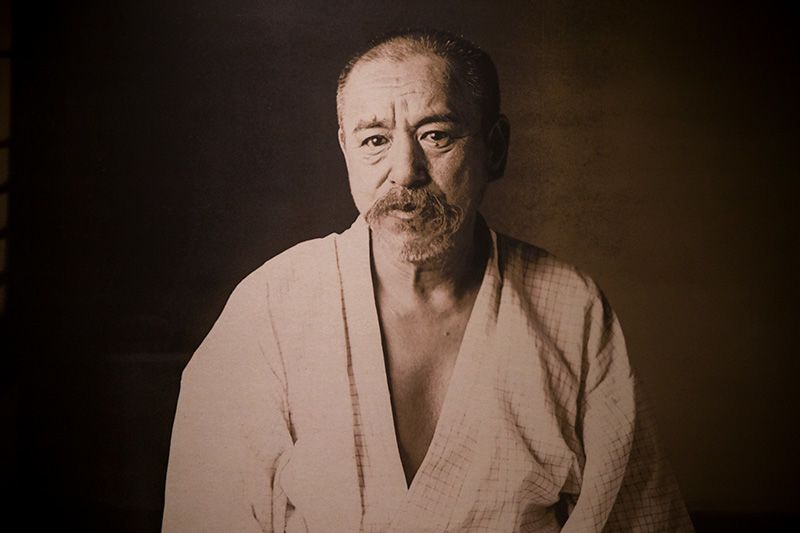 Minakata Kumagusu in later years.
Minakata Kumagusu in later years.
Minakata’s Spiritual Roots
Minakata Kumagusu was born in Wakayama Prefecture, traditionally known as Kii Province, or Kishū. Its location on the Kii Peninsula exposes it to warm Pacific currents, and its tangle of mountainous terrain is lushly carpeted in subtropical vegetation. Since ancient times, these deep mountain forests have been viewed as the abode of ancestral spirits. The area is noted for its numerous sacred spots and places of worship, including major and minor shrines of the Kumano cult. The local inhabitants were deeply religious and continued to worship the ancient gods of the forests.
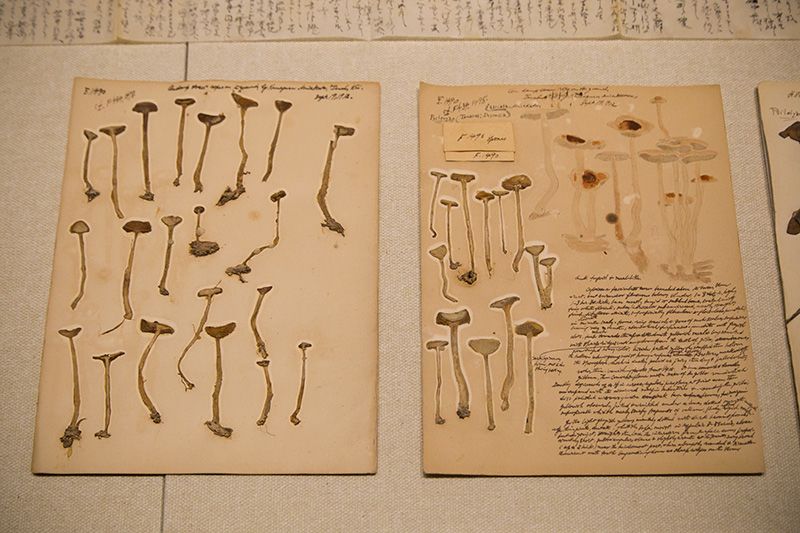 Minakata drew meticulous, delicately colored sketches of the numerous fungi specimens he collected and studied.
Minakata drew meticulous, delicately colored sketches of the numerous fungi specimens he collected and studied.
Minakata’s father was a hardware dealer in the city of Wakayama. When a son was born into the Minakata household, the infant would be taken to Fujishiro Shrine in the nearby city of Kainan to receive his name from the head priest. One of the sub-shrines of Fujishiro Shrine was dedicated to the god of the Kumano cult, and there grew on its grounds a sacred camphor tree, or kusu. In naming Kumagusu, the priest summoned a bit of the mountain god’s power to sustain the sickly child by using the character 熊 for kuma (bear), as in Kumano, combined with the character 楠 for kusu (camphor tree).
As a child, Kumagusu read deep mythic significance into his given name. It spoke to him of the underlying connection between plants, animals, and himself. He seemed to understand intuitively that human beings and other life forms are fundamentally the same and inextricably linked to one another at the deepest level. This sort of animistic pantheism is implicit in the traditional Japanese worldview, but Kumagusu was to develop and embrace it as an explicit philosophy that informed both his scientific research and his social activism.
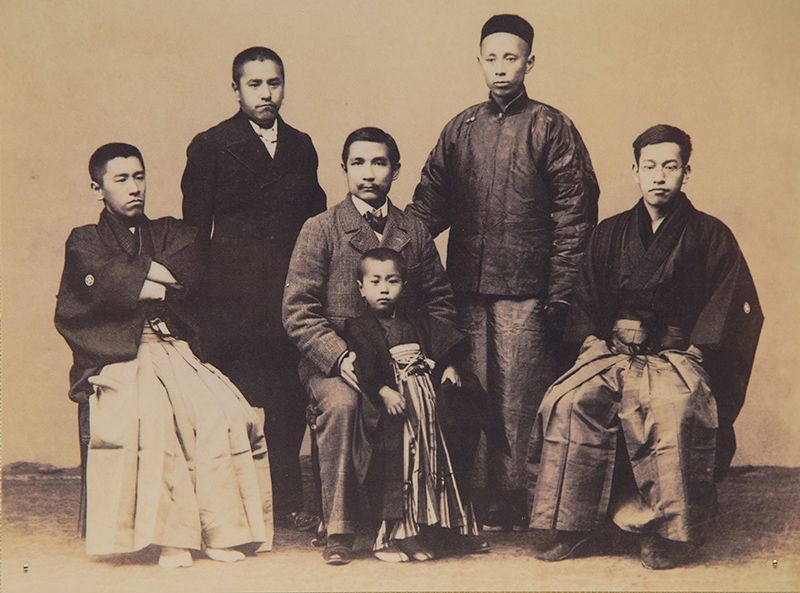 Minakata Kumagusu (second from left) and his family pose in a 1901 portrait with Sun Yat-sen (seated to Kumagusu’s right), whom Kumagusu met while living in London. The other subjects are (left to right), Kumagusu’s younger brother Tsunegusu, Tsunegusu’s son Tsunetarō, the Chinese interpreter Wen Bingchen, and another younger brother, Kusujirō.
Minakata Kumagusu (second from left) and his family pose in a 1901 portrait with Sun Yat-sen (seated to Kumagusu’s right), whom Kumagusu met while living in London. The other subjects are (left to right), Kumagusu’s younger brother Tsunegusu, Tsunegusu’s son Tsunetarō, the Chinese interpreter Wen Bingchen, and another younger brother, Kusujirō.
Making a Name Abroad
At the age of 19, after failing an exam at the official preparatory school for the University of Tokyo (Tōkyō Daigaku Yobimon), Minakata decided to travel abroad and pursue his dreams in the United States. At first he was enrolled at the Michigan State School of Agriculture, but he soon withdrew and devoted himself to collecting biological specimens. From Michigan he traveled south, exploring Florida and then Cuba, where he discovered a new species of lichen.
In September 1892, Minakata left the United States and journeyed to London. The very next year the prestigious science journal Nature published his article “Constellations of the Far East,” which was well received. He became a regular visitor to the British Museum, where he read voraciously on such wide-ranging subjects as archeology, anthropology, and religion. He also developed friendships with a number of noted scholars, including the orientalist Frederick Dickins, and found work cataloging Eastern books and manuscripts in the museum’s collection.
Over the next few years, as he continued to publish original and thought-provoking pieces in Nature and other journals, Minakata gained recognition among the British intelligentsia. However, his behavior came under increasing scrutiny, especially after an incident in 1898, in which he struck an Englishman in the British Museum for uttering anti-Japanese slurs. In 1899, he was exiled from the museum. The following year, he returned to Japan after an absence of 14 years. By then both of his parents had passed on.
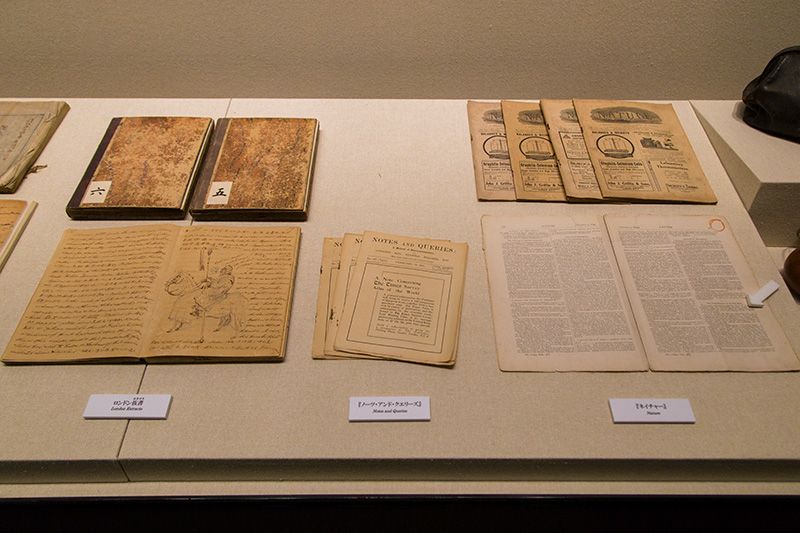 Minakata’s London years are represented by a sampling from his expertly illustrated 52-volume London Extracts (left), alongside issues of Notes and Queries and Nature, two journals to which Minakata contributed English-language essays and studies.
Minakata’s London years are represented by a sampling from his expertly illustrated 52-volume London Extracts (left), alongside issues of Notes and Queries and Nature, two journals to which Minakata contributed English-language essays and studies.
New Discoveries in the Mountains of Kumano
In those days, anyone who spent years studying overseas was expected to come back with a degree from a Western university. Minakata, who had spent 14 years pursuing his studies in the Americas and Britain for the sheer love of learning, returned to Japan with no such honors and met with a chilly reception. Not one to be deterred by society’s disapproval, he returned home to Wakayama and spent his days collecting botanical specimens deep in the region’s lush mountain forests.
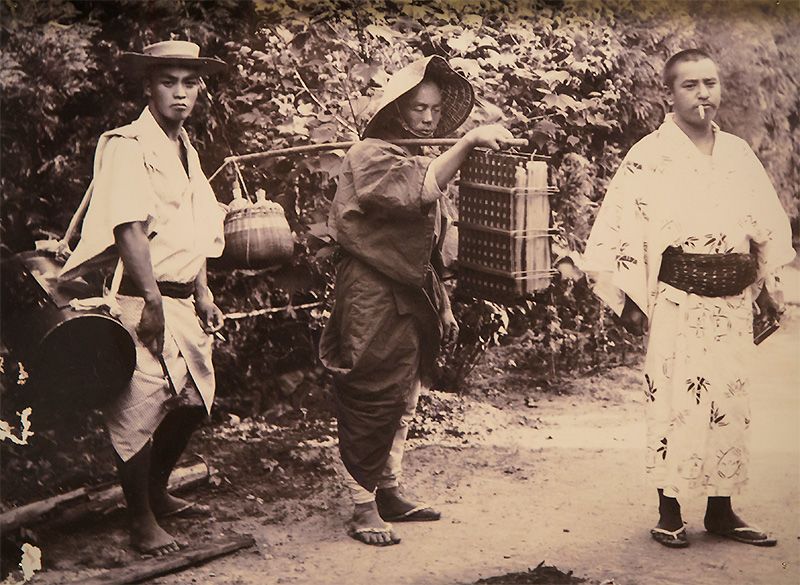 Minakata (right) setting out to collect specimens.
Minakata (right) setting out to collect specimens.
In 1904, Minakata took lodgings at the Osakaya inn adjacent to Kumano Nachi Taisha, one of the three principal Kumano shrines. With this as his base camp, he spent the next few months exploring the area’s vast virgin forests, a treasure trove of lichens and slime molds. By day, he would set out—usually alone—to collect specimens in the mountains of Kumano. By night, working by lamplight, he would use a microscope to examine and sketch his finds and write up descriptive labels.
Among the few books that Minakata brought with him to read during this retreat was an extensive treatise on the doctrines of Kegon Buddhism: Huayan wujiao zhang (Treatise on the Five Teachings of Huayuan), by the seventh-century Chinese monk Fazang. Studying Buddhist doctrine in the solitude of the mountains, he achieved a new level of spiritual and mental clarity. It was a period of extraordinary intellectual fertility in which his preternaturally active mind spouted one startling new idea after another.
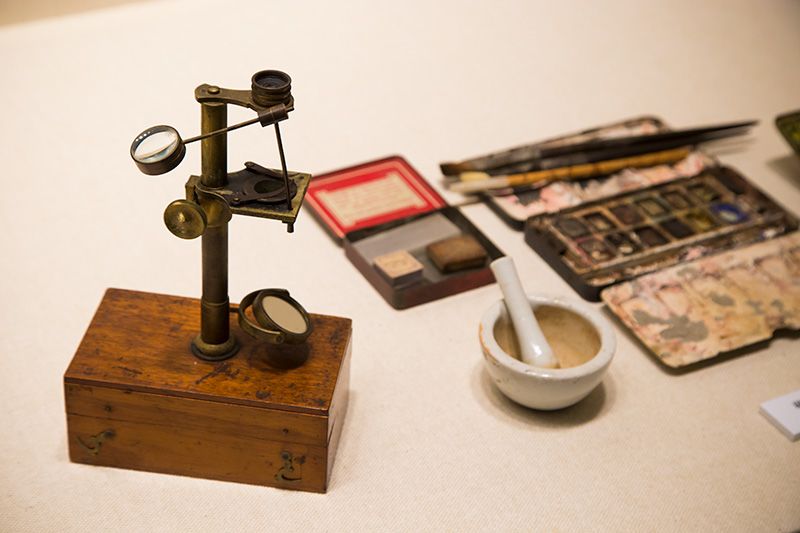 Minakata’s microscope and sketching materials.
Minakata’s microscope and sketching materials.
During this period, Minakata summed up his wide-ranging ideas on science, religion, and metaphysics in a long letter to the Shingon Buddhist priest Doki Hōryū. He stayed up nights composing the letter, which filled a roll of paper more than 10 meters long by the time it was finished. In a passage of particular interest, Minakata questions the basic assumptions of modern science and envisions a new knowledge paradigm that transcends the limits of Western science by incorporating Buddhist doctrine.
Western science, as Minakata explains, relies on linear cause-and-effect relationships to illuminate the workings of nature, but such relationships reveal only one narrow facet of reality. The Buddhist doctrine of pratitya-samutpada—known as engi in Japanese—teaches that all phenomena arise together in an interdependent web of causality. Minakata felt that such a worldview opened the way for a far more complex, expansive, and multidimensional approach to science. To explain the structure of this expanded “science of the future,” he used higher-order logic, aided by a variety of metaphors and diagrams, including the “Minakata mandala” that has become a subject of intense research in recent years.
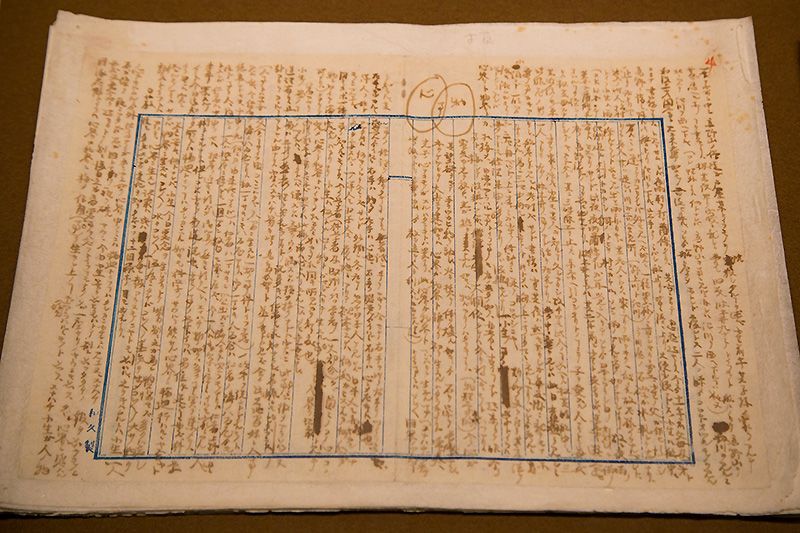 A section of Minakata’s letter to Doki Hōryū.
A section of Minakata’s letter to Doki Hōryū.
Years of Environmental Activism
Minakata greatly advanced the science of botany with his discoveries in the mountains of Kumano. At length he emerged from his retreat and settled in the coastal town of Tanabe to the west. In 1906, at the age of 40, he married Matsue, daughter of the chief priest of the local Tōkei Shrine, and the couple were blessed with a son and a daughter. For a while, Minakata lived a quiet but full life in Tanabe. He discovered a new species of slime mold (Minakatella longifila) in his own garden and wrote fascinating essays on folklore that were published in book form during his lifetime.
These years of relative tranquility came to an end when Minakata launched his own crusade against the government’s policy of shrine consolidation. In 1906, hoping to unify Japan’s myriad local kami under the aegis of State Shintō, the Meiji government issued an edict calling for local authorities to close down the countless small and obscure shrines dotting the Japanese countryside and merge them into a few larger, centrally located facilities. Minakata recognized the threat this policy posed. The spiritual focus of these unspoiled local Shintō shrines was not their buildings but the surrounding sacred forest. Closing thousands of small local shrines would open those forests to logging and development. Fearing the destruction of all that precious natural habitat, Minakata fought tooth and nail against shrine consolidation.
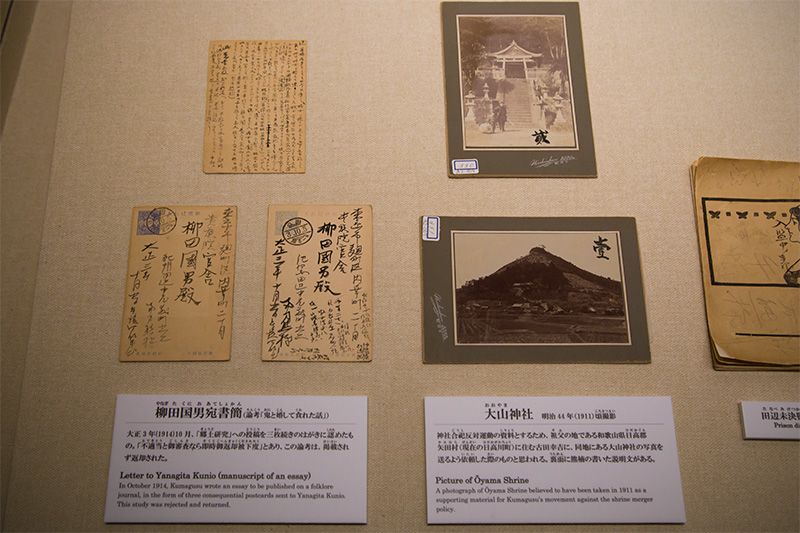 Letters addressed to Yanagita Kunio (left) and a photo used in Minakata’s campaign against shrine mergers. Ōyama Shrine, pictured in the photo at right, was one of many small shrines in Wakayama Prefecture that fell victim to the government’s consolidation policy.
Letters addressed to Yanagita Kunio (left) and a photo used in Minakata’s campaign against shrine mergers. Ōyama Shrine, pictured in the photo at right, was one of many small shrines in Wakayama Prefecture that fell victim to the government’s consolidation policy.
At the beginning, his protests fell on deaf ears. But Minakata’s dedicated opposition gradually fueled a movement. Two political pamphlets composed by Minakata and distributed widely with the help of folklorist Yanagita Kunio were particularly influential. In 1910, Minakata was arrested and incarcerated after drunkenly disrupting a community meeting organized by officials promoting the consolidation effort. True to form, he took advantage of his time in prison to discover a new species of slime mold.
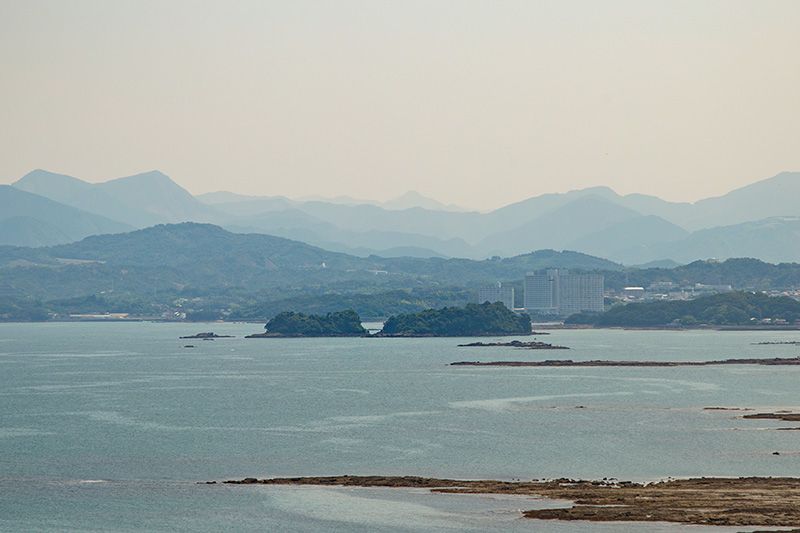 The island of Kashima (center) with Minakata’s beloved Kii Mountains in the background.
The island of Kashima (center) with Minakata’s beloved Kii Mountains in the background.
Thanks to Minakata’s tireless efforts, the shrine consolidation movement lost steam and effectively ground to a halt several years later. In the end, Minakata’s pioneering conservationism saved countless forests in Wakayama Prefecture. Among these was the island of Kashima off the coast of Tanabe. Rich in rare plants, it was designated a natural monument in 1935. Several years earlier, Kashima had been the scene of a pivotal episode in Minakata’s life.
In the spring of 1929, Minakata was asked to deliver a lecture to Emperor Shōwa—himself an avid student of slime molds—during the monarch’s visit to Wakayama. It was an unprecedented honor for a commoner. On June 1, Minakata delivered his lecture aboard the imperial ship Nagato as it lay anchored off the coast of Kashima and presented the emperor with a set of samples packed in empty candy boxes. It was the proudest moment of his life.
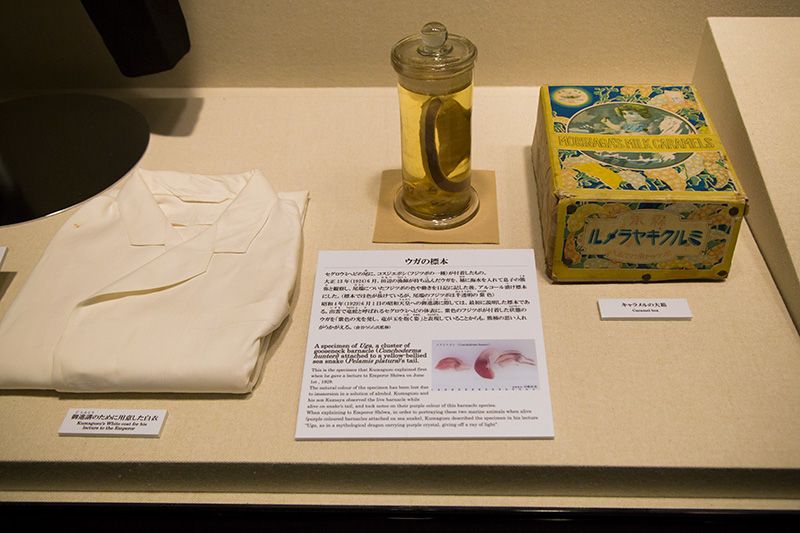 Mementos of Minakata’s lecture to Emperor Shōwa. From left to right, the lab coat he bought for the occasion, the sea snake barnacles that featured in his lecture, and one of the candy boxes he used to package specimens for presentation to the emperor.
Mementos of Minakata’s lecture to Emperor Shōwa. From left to right, the lab coat he bought for the occasion, the sea snake barnacles that featured in his lecture, and one of the candy boxes he used to package specimens for presentation to the emperor.
Minakata Kumagusu died in 1941 at the age of 75. Today, more than ever, he is revered not only for his remarkable achievements as a pioneering botanist, ecologist, anthropologist, and folklorist but also as a maverick with the strength and purity of spirit to live life on his own terms.
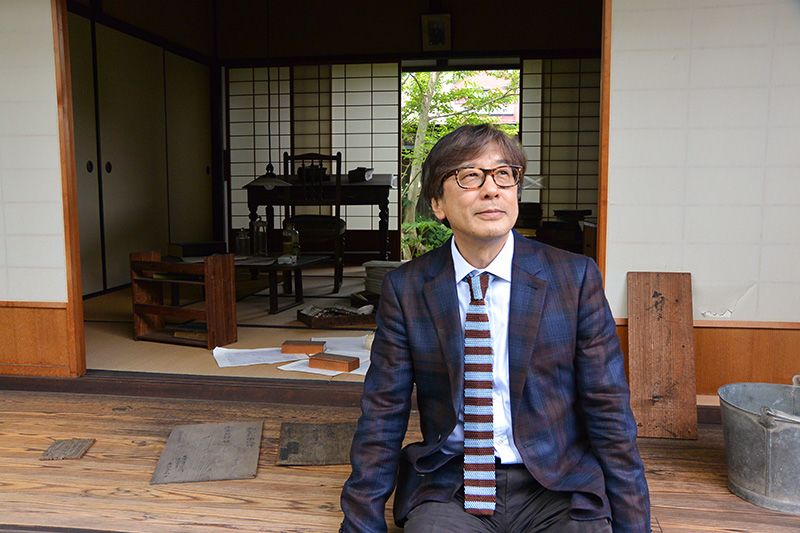 The author at Minakata Kumagusu’s residence in Tanabe, Wakayama Prefecture.
The author at Minakata Kumagusu’s residence in Tanabe, Wakayama Prefecture.